Anker is a popular brand among computer geeks, but can they win the respect of no-nonsense armed citizens, cops and those in the military with its like of flashlights?
I decided to do an Anker LC90 review after I saw the affordable flashlight marketed as a “super bright tactical flashlight” on Amazon. The results may surprise you.
The Anker brand made a fairly good name for itself selling electronics accessories. From battery packs to phone chargers, Anker offers a broad range of products that frequently get excellent reviews. I’ve used some of its gear and found my purchases to be pretty good products for the money.
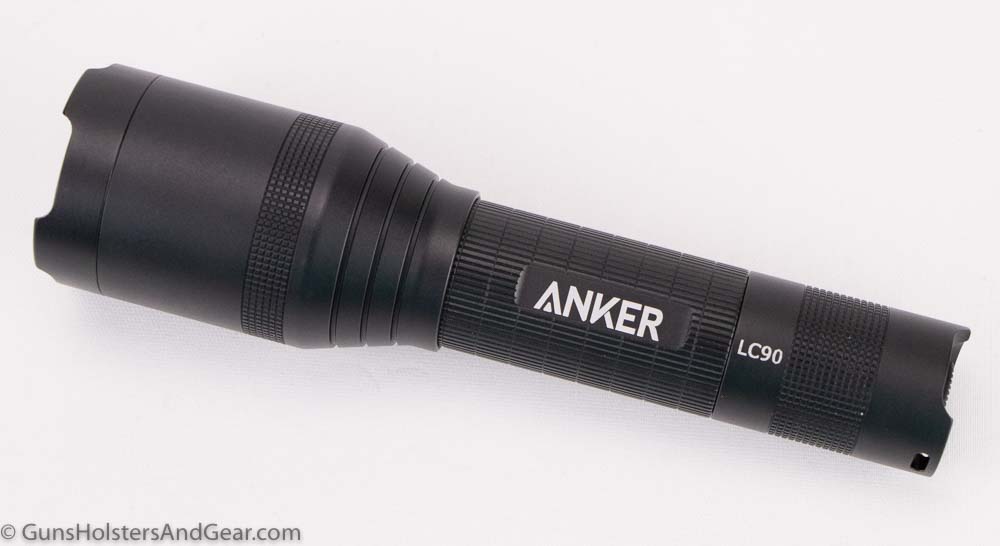
When I found the company made a 900-lumens torch with an average rating of 4.6 of 5 stars with more than 14,000 Amazon reviews, I ordered one up. I figured this would be a real winner.
Unfortunately, this Anker LC90 flashlight review is an example of why independent testing and skepticism are important, and reviews on an e-commerce site may not be as reliable as you would hope.
General Information
The Anker LC90 is a handheld flashlight with an aluminum body and a zoomable head. A 18650 rechargeable battery (3350 mAh) is included with the light. A micro-USB cable is used to charge the battery while it is in the light.
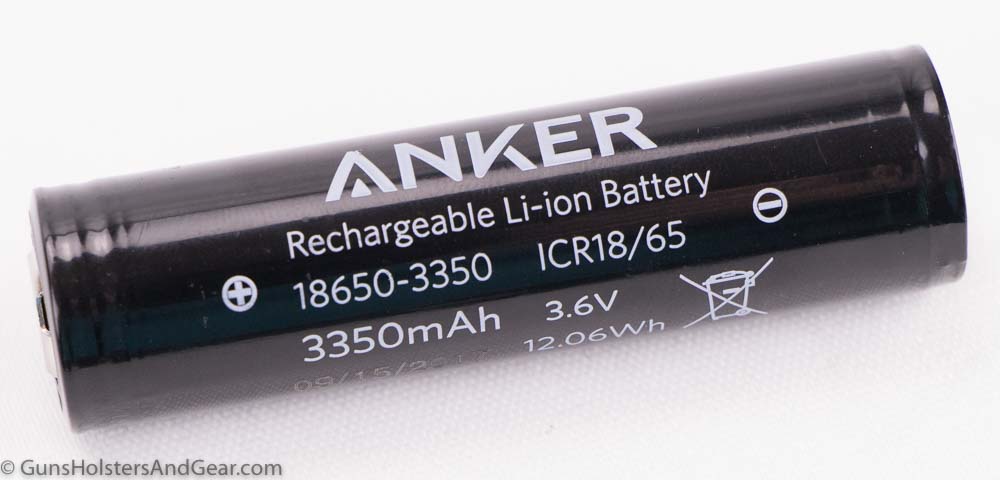
The company’s sales page on Amazon describes it as a “Super Bright Tactical Flashlight.” However, the Anker website lists the LC90 in its “home improvement” products.
Anker states the light is dust and water-resistant with an IP65 rating. This means that no dust can get into the sealed flashlight, and it can resist significant water splashing and rain. It is not rated for immersion protection like many true tactical flashlights.
Don’t drop it into a pool, river or puddle. It will probably handle a moment underwater, but at some point, water will make entry and foul up the circuitry.
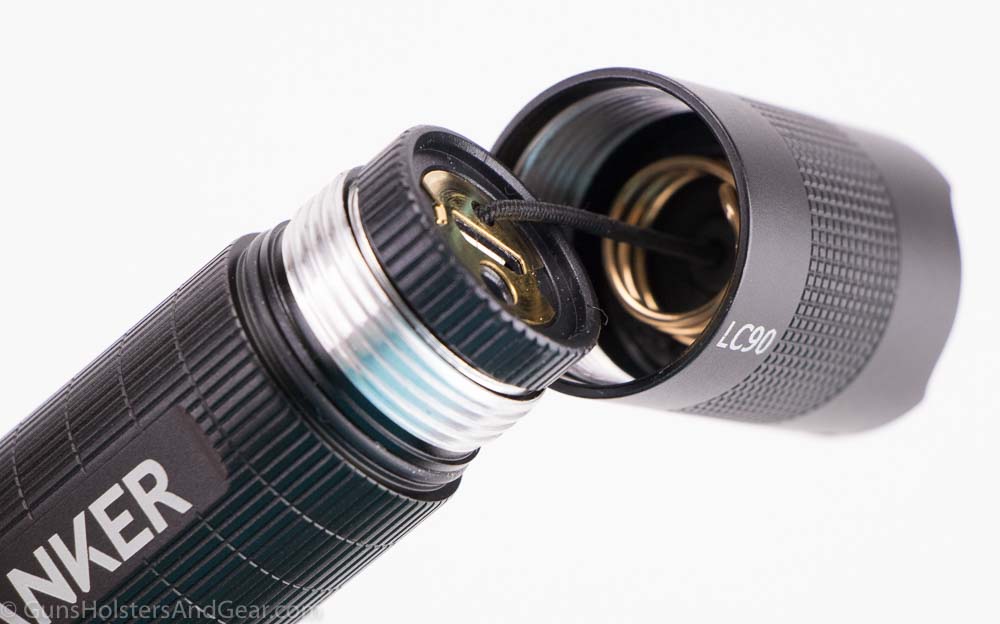
I expect that the LC90 is not submersible mainly because of the in-light charging circuitry. Most lights that allow you to charge the battery like this are not submersible because the charging port isn’t sealed.
Anker placed the charging port under the tail cap. The tailcap must be fully removed to access the port, so I had hoped Anker managed to make this waterproof. Alas, the company did not. I’m not sure why Anker failed to make this happen.
At the time of this writing, it sells for $25.99 and is available through Amazon Prime.
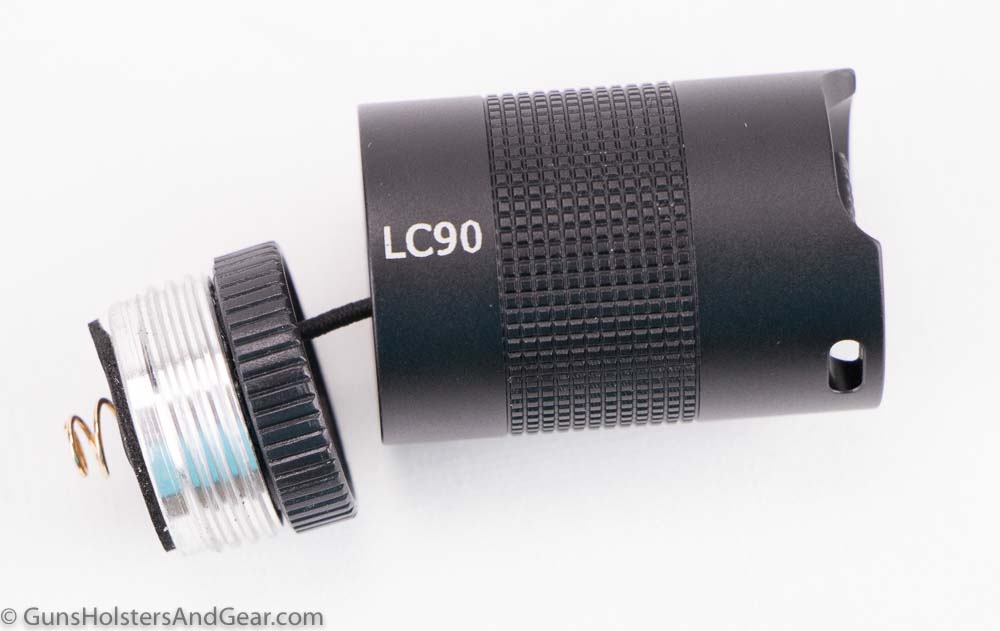
Manufacturer Specifications
Anker lists the flashlight specifications in a table that seems to suggest compliance with the FL1 flashlight standard issued by ANSI/PLATO. To me, the icons look very similar to the ANSI/PLATO icons and the table is labeled as “FL1 Standard.” However, the information appeared to not conform to the FL1 standard it claimed. You can see the table on the right side of this review (or above if you are on a mobile device.)
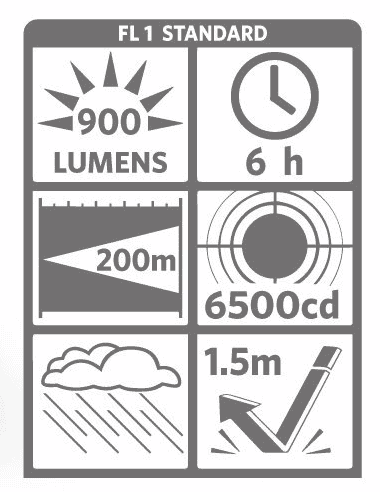
The ANSI/PLATO FL1 flashlight standard is exacting both in how flashlight performance is to be tested and how that information is displayed to consumers. I immediately observed that the impact resistance rating appeared to be out of compliance with the standard.
Anker lists the impact resistance as 1.5 meters in the FL1 Standard box. However, the FL1 standard as section 2.6.6 (page 12) clearly states that:
Ratings in excess of 1m shall be reported with values rounded down to the nearest whole meter.
This means that if Anker was in compliance with the FL1 standard, the impact resistance should be reported a 1 meter.
When one of the specifications appears to be out of compliance with the standard, it caused me to question if any of the reported information was actually in compliance. So, I contacted Anker’s customer support through the company’s website.
I asked “I was looking at your LC90 flashlight. Can you advise if this was tested in accordance to the FL1 flashlight standard?” I received the following response (highlighting added):

Advertising a product as having passed certain criteria when it has not been tested to that standard is a serious problem. I don’t know why the company allowed this to happen, but in my mind, it casts doubt on all of the products it makes.
Some people might say that Anker printed the information in this way to intentionally mislead consumers. I have no evidence of this. However, I see this as a major problem.
I contacted PLATO via the organization’s website to inquire about Anker’s use of the “FL1 Standard” label and similar icons. PLATO is responsible for enforcing the use of its trademarks and proprietary information. According to an organization representative I spoke with in the past, the organization takes consumer confidence seriously and investigates all potential misuses of its standard.
Unfortunately, I never received a response from PLATO and Anker continues to use a “FL1 Standard” label and similar icons in its LC90 manual (seen here.) For reference, I originally contacted Anker and PLATO in November 2017 and it is now July 2018 when I am writing this.
Light Output
Anker states the LC90 flashlight has a total light output of 900 lumens and a peak beam intensity of 6,500 candelas. This suggests that the light will be bright but spread over a wide area – not in a tight spot pattern.
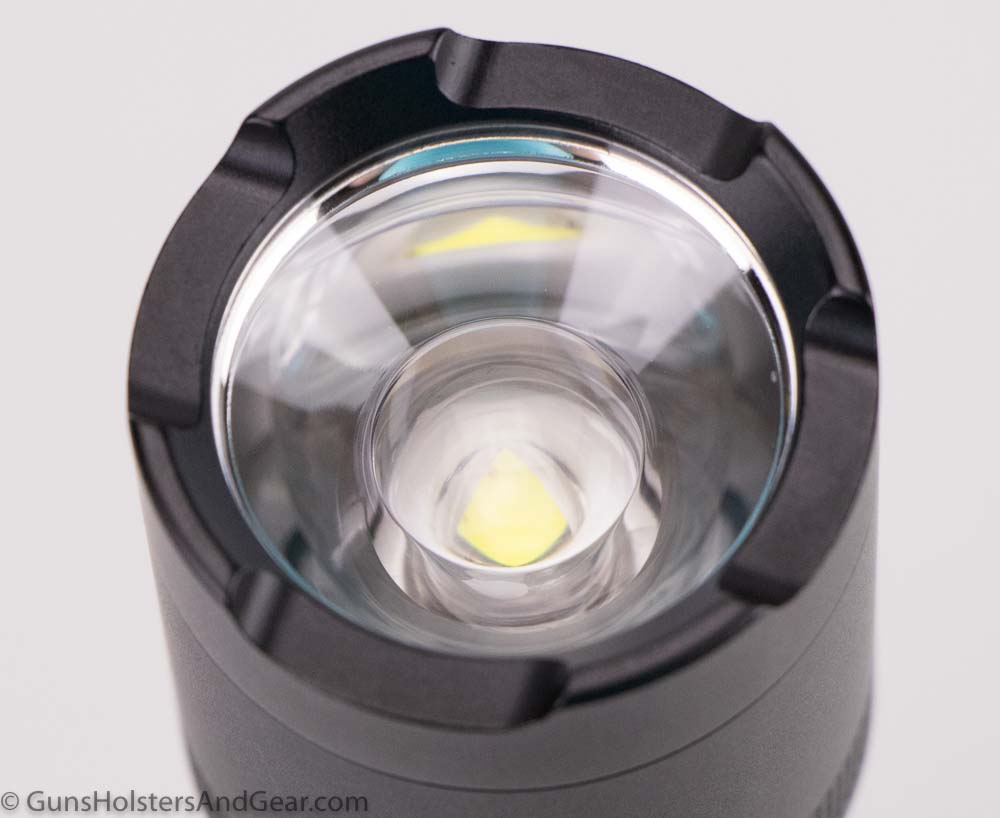
However, the head of this light is zoomable. This means you can change the pattern from a flood to a spot pattern. Based on my use of the light, I suspect the candela measurement was taken at the flood pattern. The peak beam intensity of the spot pattern appears to be much brighter than 6,500 candelas.
If you are unfamiliar with what lumens and candela measure, don’t worry: most people are confused by them and some flashlight companies have taken advantage of this over the years.
Lumens measures the total light output from a source regardless of where it may be focused. Candela measures the peak beam intensity – typically that bright center spot – from a light source.
If you think of a bare lightbulb, it may have a high lumen measurement because it puts out a lot of light. Since that light is not focused anywhere, the candela measurement will likely be small.
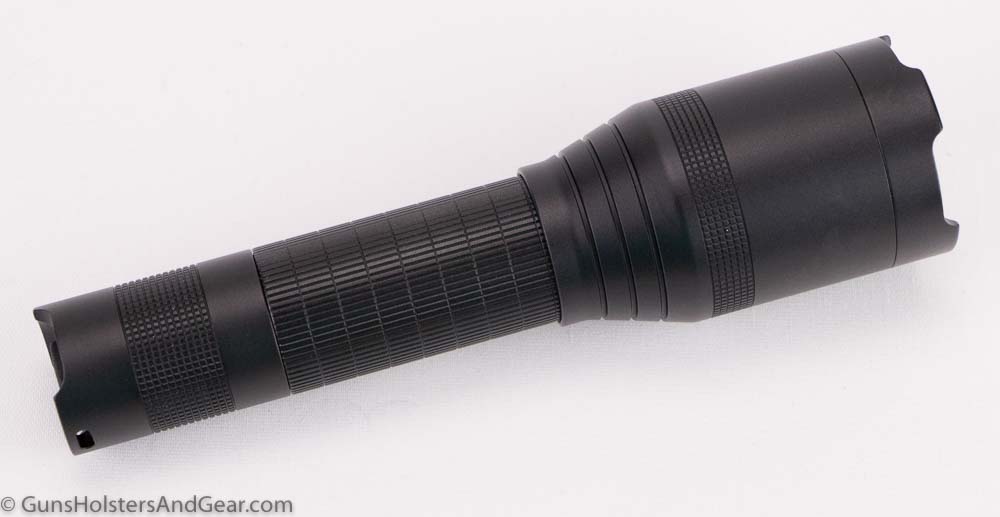
Conversely, a handheld searchlight may have a high lumen measurement and a high candela measurement because the light is both very bright and very focused.
Flashlights with low candela measurements compared to their total light output tend to offer a flood pattern while high candela measurements for a similar output level suggest a more focused beam. Neither is “better,” but one may be better suited for your needs.
Controls
The Anker LC90 has a tailswitch that handles all of its different modes and activations. As the Anker has five different modes, this proved to be problematic in actual use.
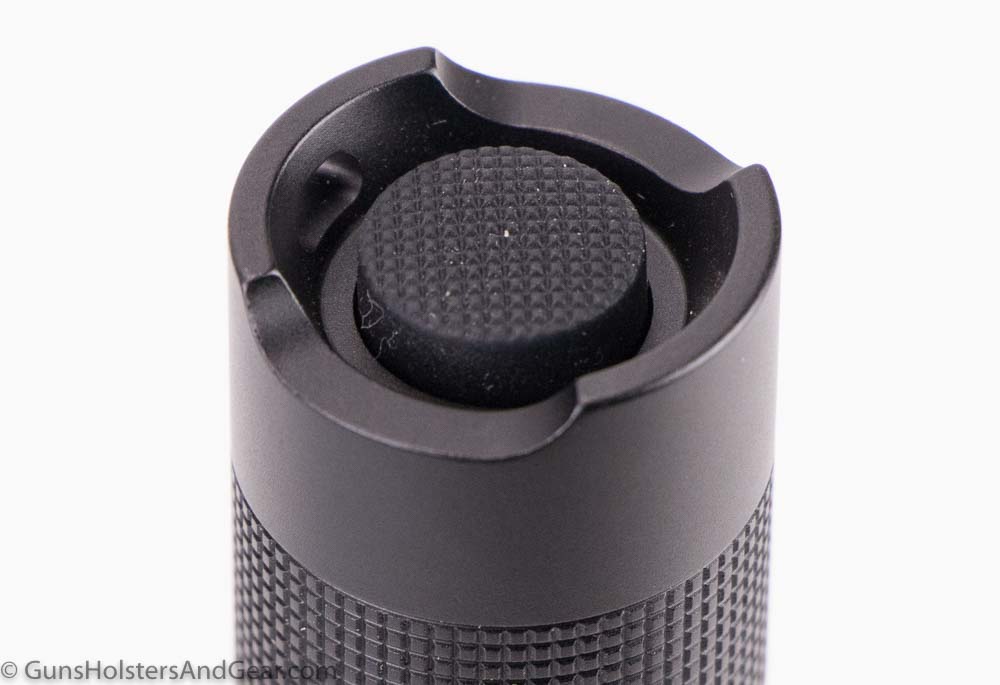
To activate the light, you can half-press the switch for a momentary activation. You can also fully depress the switch to get a constant-on activation.
The same switch is also responsible for rotating sequentially through the five different modes: high, medium, low, strobe and a Morse code SOS.
Anker designed the switch to advance the mode by one position with each momentary press made within two seconds of each other. This creates a problem if you are clearing an area and flashing the light on and off – the light literally begins to cycle through the different modes.
If Anker reduced the time between activations from 2 seconds to less than 0.5 seconds, it would likely avoid this problem entirely. The flashlights manufactured by Streamlight manages this very well in my experience.
Of course, the ideal solution would be a way to program the light to only activate at the high output level when using the momentary switch. This would prevent all problems. For a light marketed as a tactical light, this seems to be a no-brainer. But, Anker is not a company that appears to be familiar with the needs of law enforcement, military and armed citizens.
My dad once told me that a tool that tries to do everything will likely fail at all of them. His concept is that a tool should be designed to do one job very well. Even though this light is sold on Amazon as a “tactical” light, the inclusion of different modes and the clumsy way of accessing them causes the light to be unsuitable for tactical use.
Charging the 18650
Charging the 18650 battery is handled within the light. An included micro-USB charging cable plugs into the rear of the light to power it up. A red LED illuminates letting you know it is charging.
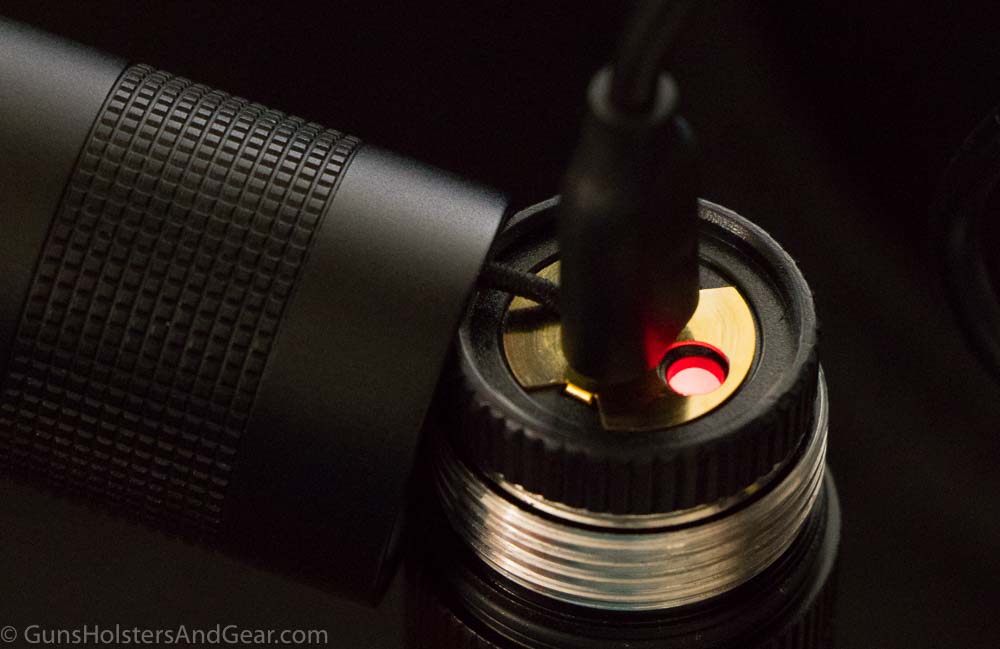
The problem with the charging system is that you have to disassemble the rear of the flashlight to access the charging port. This means that you cannot keep the Anker flashlight on the charger and have it instantly ready for an emergency.
So, for the homeowner keeping a light next to his or her bed, or the cop working a long night shift, this is a significant drawback. It may not be a deal killer, but it is an issue you will have to workaround.
I could have better understood the location of the charging port if its placement allowed Anker to make the flashlight submersible. Since it is not, I can’t really fathom how its placement makes a lot of sense for the end user.
Testing
Testing the actual performance of a flashlight is important. In fact, it may be the most important aspect of a flashlight review. After all, if the Anker LC90 doesn’t measure up to what the company claims, is it a light you want to buy? Probably not.
As with my other flashlight reviews, I use a series of tests that are similar to the FL1 standard. Due to a number of reasons, my tests are not the same as the ones in the ANSI/PLATO protocols. However, the tests do allow readers to make reasonable comparisons between the lights I have previously reviewed. The information also allows you to draw your own conclusions about how well a manufacturer has represented its product.
Output Over Time
Measuring output over time is one of the primary tests I perform on any flashlight I am reviewing. After all, a light that puts out a lot of light, but only for 2 minutes is not likely something most of my readers will be interested in buying.
Anker lists this light as having a runtime of 6 hours. It also lists the total light output as 900 lumens. A casual observer might think that means the light will put out 900 lumens constantly for 6 hours. This would be a false assumption based on the way specifications are presented. This assumption is one that most flashlight manufacturers hope you make, and is not some special trick invented by Anker.
In general terms, FL1 Standards say that runtime is measured as the total time from the peak output when the light is first turned on with a fresh battery to the point where light output drops to 10% of the original output. This means that even if a company is testing to the FL1 standard, it is reporting an 89% reduction in light output as part of its runtime.
I test output of a light in a homemade integrating sphere. This sphere is the same one used for all of my flashlight testing. It will not measure absolute output in lumens. However, it will show how long it takes a light to drop from 100% output to 10%.
Below is a graphical representation of the light output from the Anker LC90 over time.
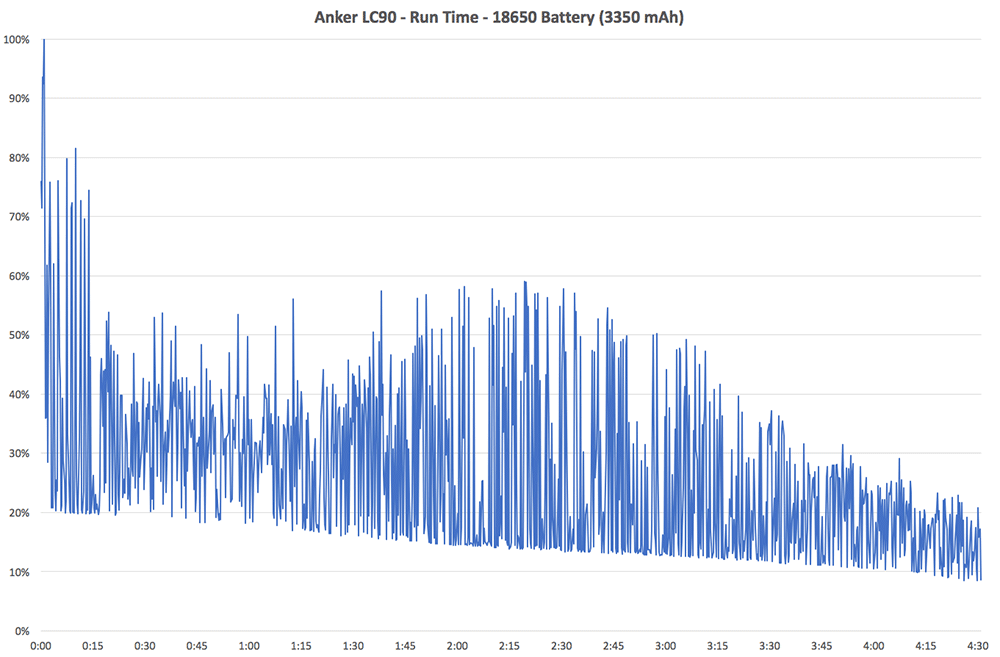
From 100% output to less than 9% output – the generally accepted measurement in the industry – the LC90 showed a runtime of 4 hours 17 minutes. This is significantly short of the 6 hours advertised by the company, but still fairly long.
However, I do not think that a run to 10% is a fair measurement for consumers. Instead, I believe the runtime measurement should represent the amount of time it takes for a flashlight to drop from 100% to 75%. However, I’ve suggested that the FL1 standard be modified to reflect the time it takes to drop from 100% to 50%.
If I hold the Anker LC90 to the 50% standard I’ve proposed, the flashlight would have a runtime of less than 2 minutes.
Let me repeat that – in my testing, the Anker LC90 took less than 2 minutes to drop its output to below 50% its initial, maximum output.
Don’t you think that is a more telling measurement than the accepted 10% standard?
In fairness, I repeated the runtime test a second time. The results were very similar to the first test’s and did not show an improvement for the 50% runtime standard I have proposed.
I followed up with Anker to see if the company employed any “feature” that would automatically drop the power output. Specifically, I asked “Does the flashlight reduce the brightness level when run on high? In other words, if I am running it on high, will it automatically drop the output level at some point automatically?”
Anker replied: “We would like to explain that along with the change of the power, the flashlight will decrease its brightness inconspicuously. But there is no a special point where the flashlight drops the output level.”
A drop to less than 50% of the initial output in less than 2 minutes is not acceptable performance for me.
Heat Generation
Some high-output flashlights get extremely hot when run for an extended period of time. Some of the flashlights I have tested exceeded 200° F, which is too hot to hold in a bare hand. This graph shows the surface temperature of the Anker LC90 flashlight over time when running at the high output level.
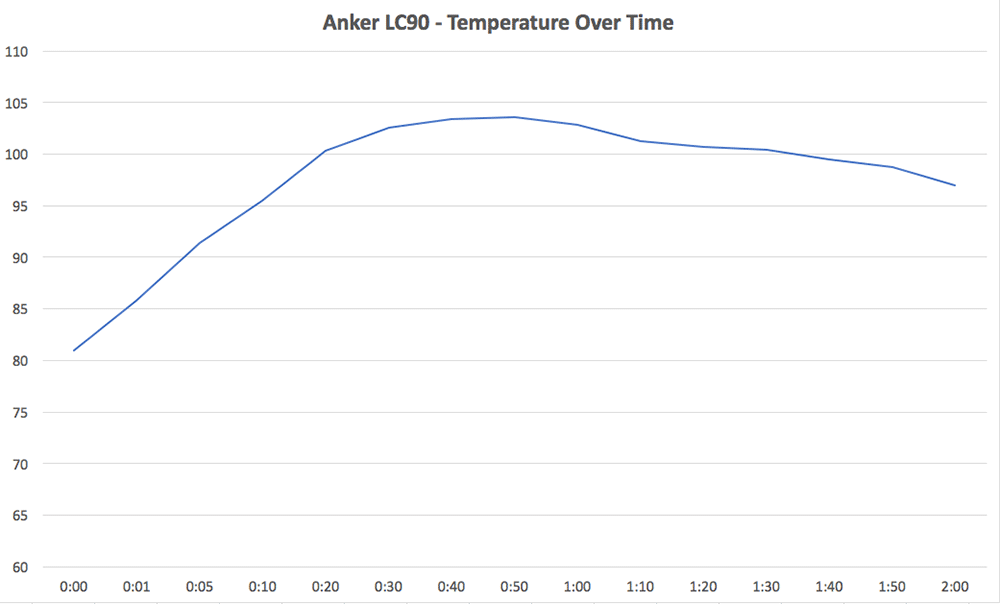
As you can see, the LC90 remains relatively cool for the duration of its run. I suspect that this is partially because of how quickly light output drops.
Visual Comparison
There is some truth to the idea that a picture is worth a thousand words. While the data and tables above help to explain how the flashlight performs, the following photos actually show you.
Since the LC90 flashlight has an adjustable beam, I photographed the light at the widest beam and most zoomed in. The photo below shows the widest beam. Drag the slider in the middle of the photo left and right to reveal more or less of the photo. The dark section is a photo of the same scene without the flashlight on.


The photo below shows the most focused or tightest beam:


To compare between the two, below are the two photos from above:


The light – both focused and with the wide beam – is extremely bright initially. Since I measured a sharp drop in light output when doing the runtime test, I photographed the light after just 10 minutes of running. This is a comparison of the initial brightness (wide beam) on the left and the brightness after 10 minutes on the right:


I also photographed the most focused beam after 10 minutes. The initial photo is on the left with the 10 minute runtime photograph on the right:


As you can see, there is a noticeable drop in light after just 10 minutes of running. This coincides with the measurements I recorded during the runtime testing. Hopefully, it will give you a better understanding of what that chart means in actual use.
(Note: All photos taken with a Canon 80D and a 50mm f1.8 lens. Settings: f8.0 at 2 seconds with manual focus.)
Drop Test
To test the impact resistance of a flashlight, I use a method similar to that employed in the FL1 standard. In my test, I drop the flashlight six times onto a concrete sidewalk from the height specified by the manufacturer’s rating. If you think of a flashlight as a cube, I drop the light once on each “side.”
In my test, the Anker LC90 continued to work after each of the six drops. The housing was obviously damaged from the falls, but none of the damage appeared to affect the light’s integrity.
Additional Photos
Here are some additional photos of the Anker flashlight and packaging. Click on any of them to bring up a larger view.
Final Thoughts
The information I discovered while testing the Anker LC90 is one of the reasons why I do reviews. You deserve to know the whole, unvarnished truth about products. Some do better than expected while others fail to live up the advertisements.
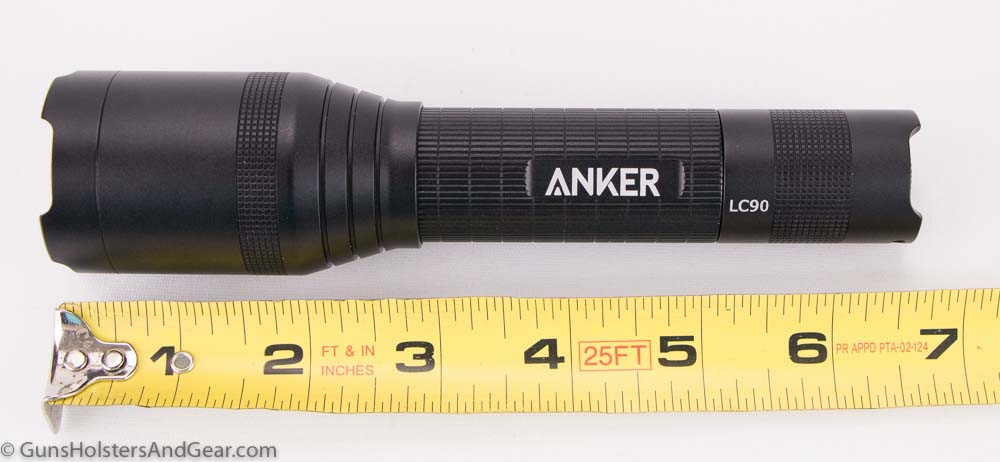
Let me be perfectly clear: I do not recommend the LC90 for any kind of tactical, self-defense, law enforcement or military use.
It may be acceptable to some people for use as a general-purpose light to keep in the truck. However, I would still suggest looking at another light that offers better runtime and improved water resistance.
At the end of the day, you get what you pay for. While the performance of this light does not live up to my expectations, it does come with a 18650 battery and can fit some roles. Many Amazon reviewers seem to like it as well. If you want to learn more about the Anker LC90, you can click here to see it on Amazon.
Alternatives
There are a broad range of handheld tactical lights on the market, and many of them offer superior performance to the Anker LC90 flashlight. One of the best flashlights for the money is the SureFire G2X (see my review here). This is my go-to EDC and tactical flashlight.
Another good light to look at is the Streamlight ProTac HL. The ProTac HL I have now is the second one I purchased. The first I carried for a year before my dad expressed an interest in it and I gave it to him. This one I’ve carried for several years, and it just keeps ticking.
If you are looking for a rechargeable tactical flashlight, the Streamlight Strion LED HL. It is more expensive, but it is a solid torch that is truly useable in tactical situations. I’ve used several as a police officer – both on a duty belt and mounted to an AR rifle. They offer a lot of performance for the money.
Others, like the Elzetta Bravo, also offer good performance. I recommend checking out my flashlight review page for additional reviews. I’m in the process of adding several new reviews, so check back often.
Last update: August 22, 2021
Disclosure
Every review you read should disclose any potential biases that might reasonably influence the results. While most writers do not, I do.
I purchased this flashlight with my own money. It is not a demo unit or T&E (an industry term for test and evaluation) sample. I purchased it from Anker through its Amazon store.
Anker did not request I review this light, nor was any form of compensation offered to review it by anyone. Although I have purchased a few products from Anker in the past, I have not had any conversations with any representative of that company about any topic.
Anker is not a sponsor, nor am I in any talks with them to be one. I have no financial interests in any flashlight manufacturer.
GunsHolstersAndGear.com is a for-profit website. I do not charge readers a dime to access the information I provide.
Some of the links on this page and site are affiliate links to companies like Amazon and Palmetto State Armory. These links take you to the products mentioned in the article. Should you decide to purchase something from one of those companies, I make a small commission.
The links do not change your purchase price. I do not get to see what any individual purchases.
If you have any questions, please leave a comment in the section below and I will do my best to answer them.
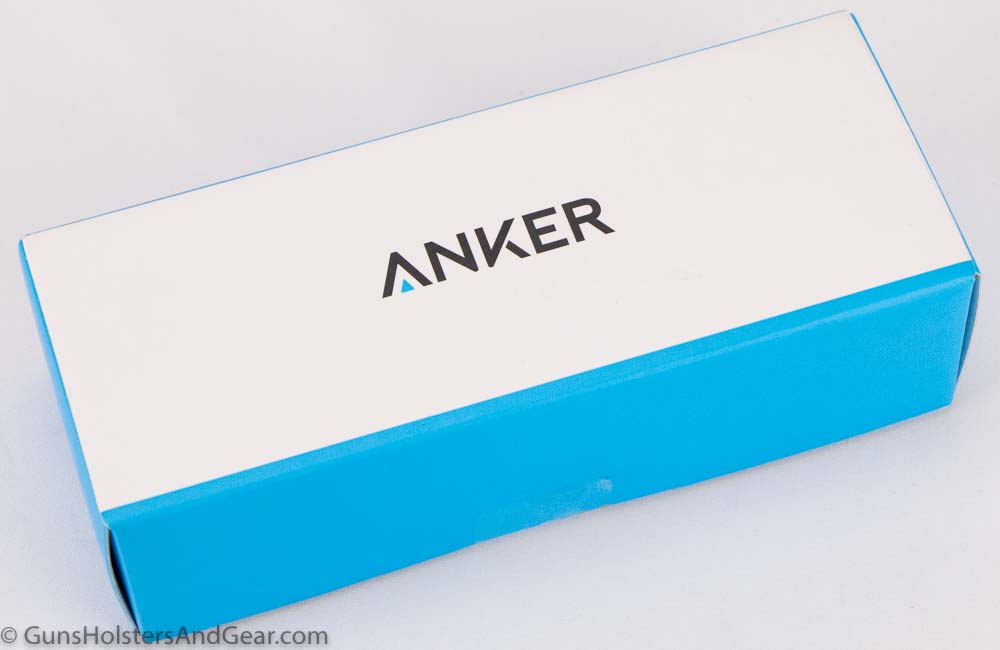
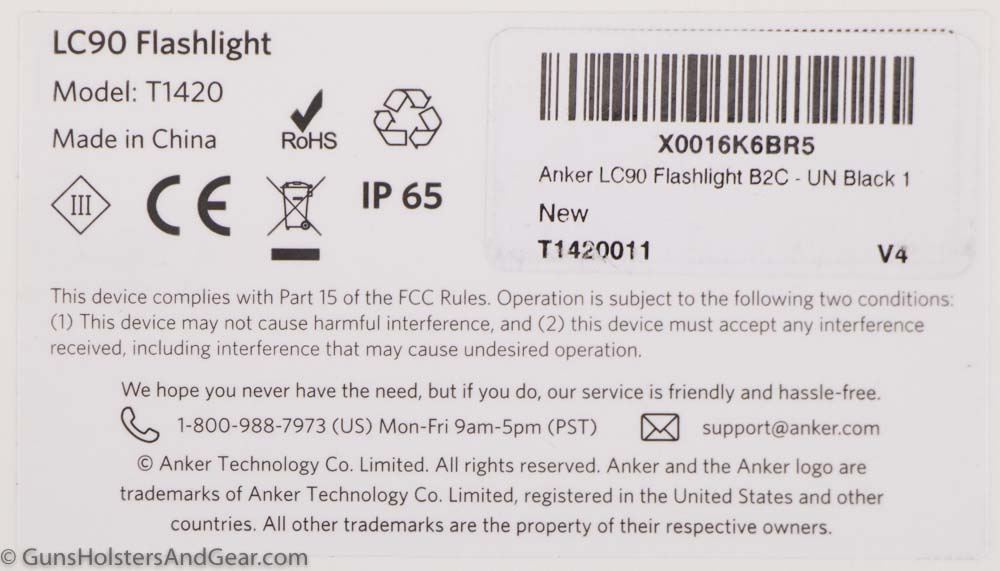
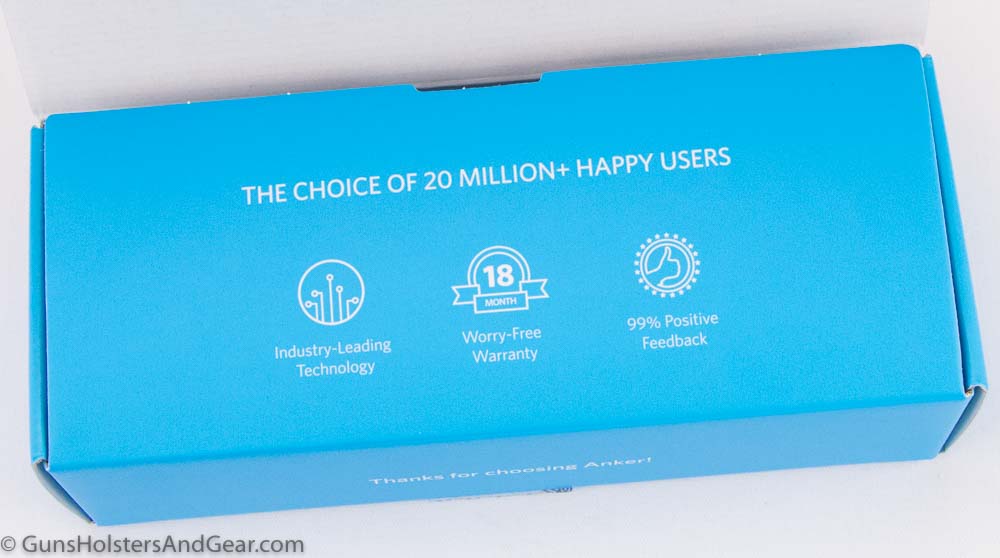
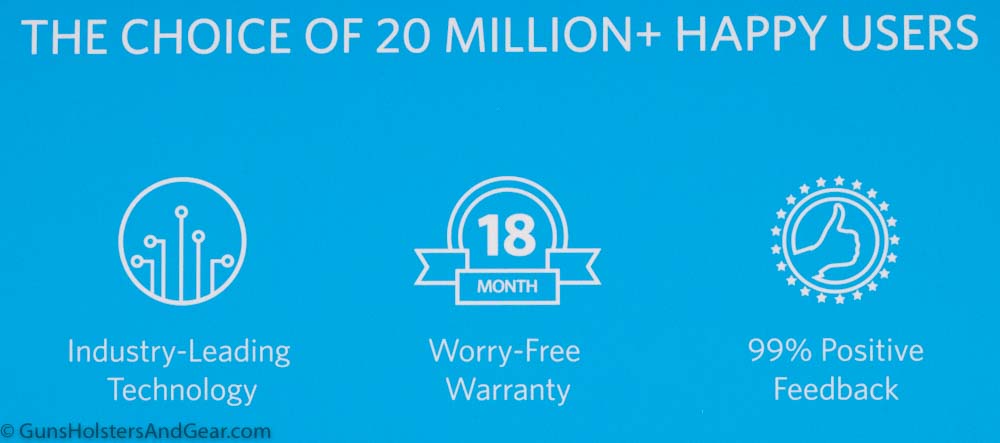
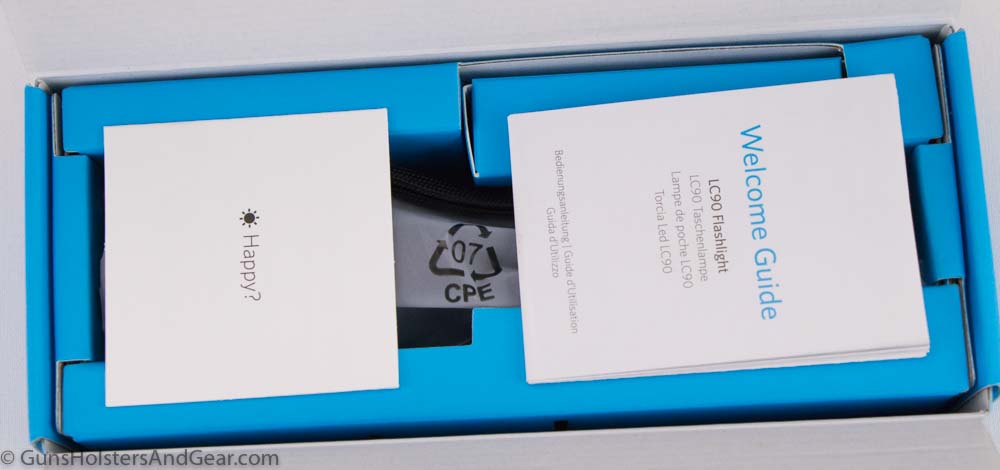
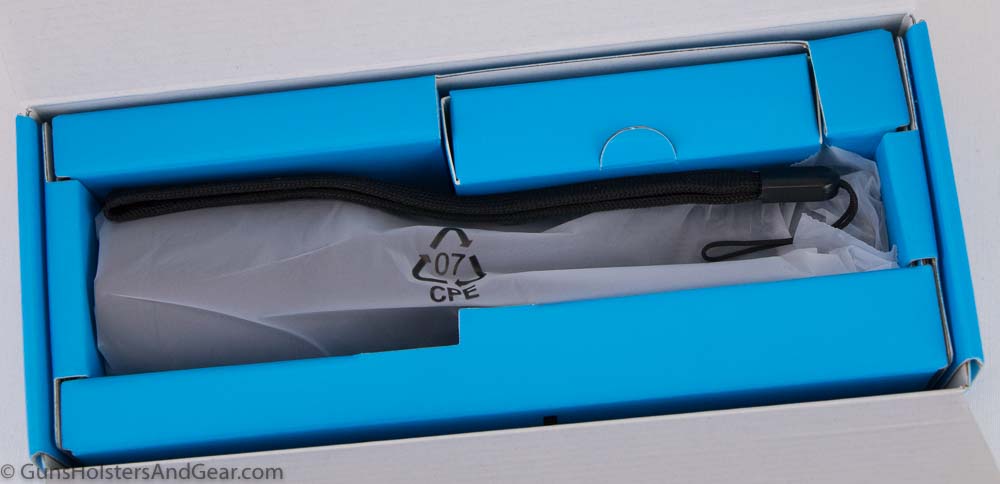
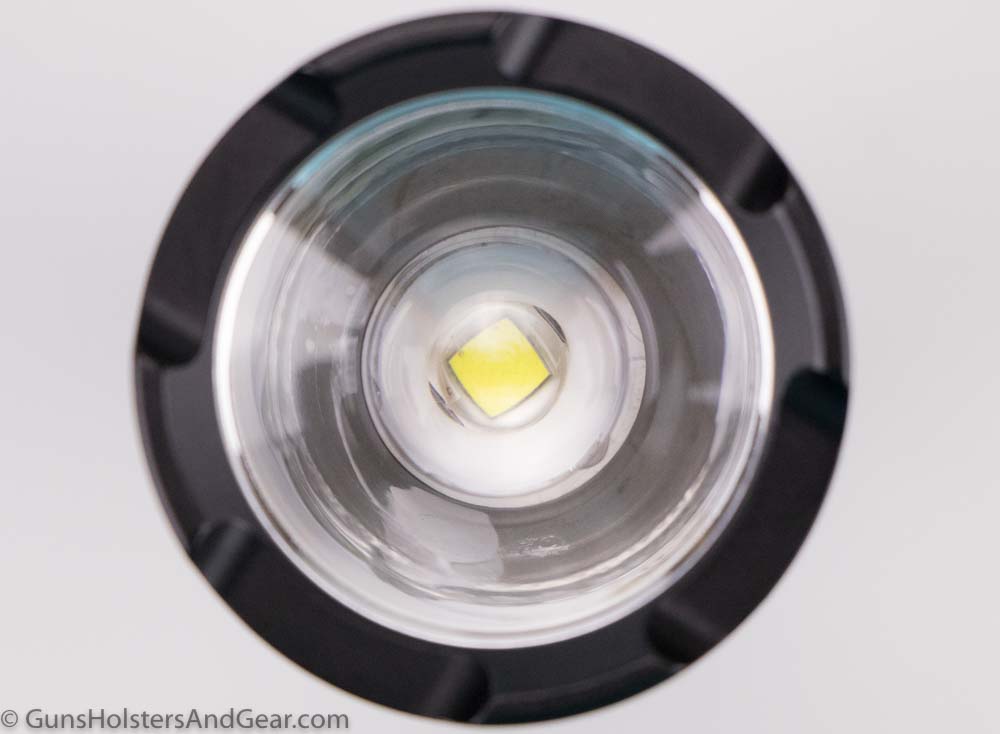
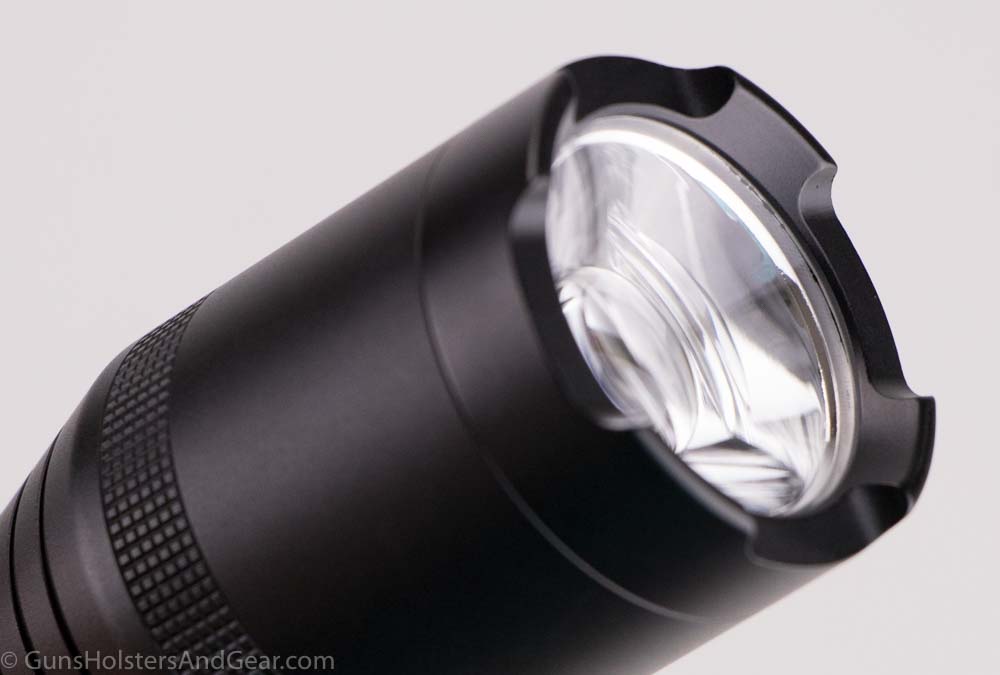
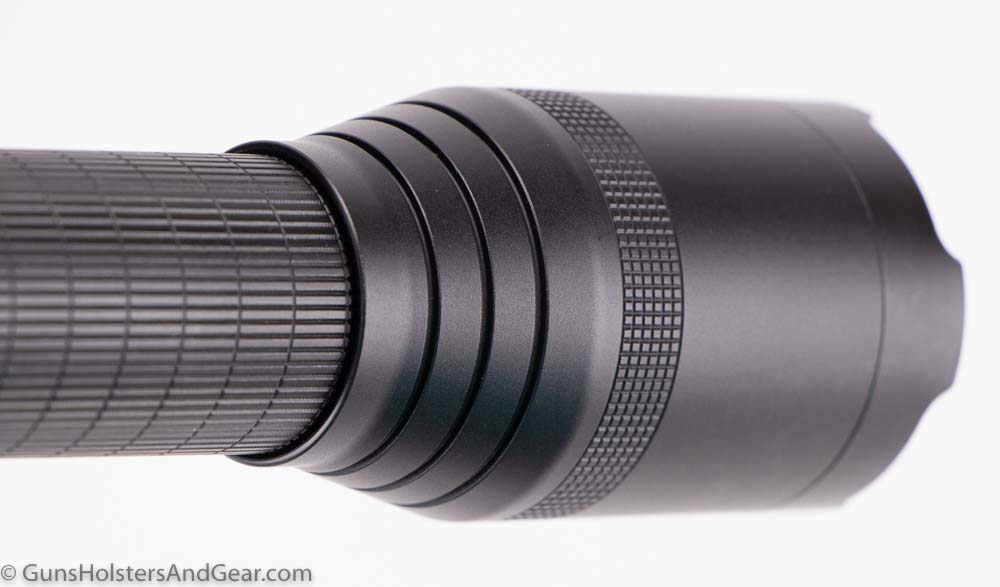
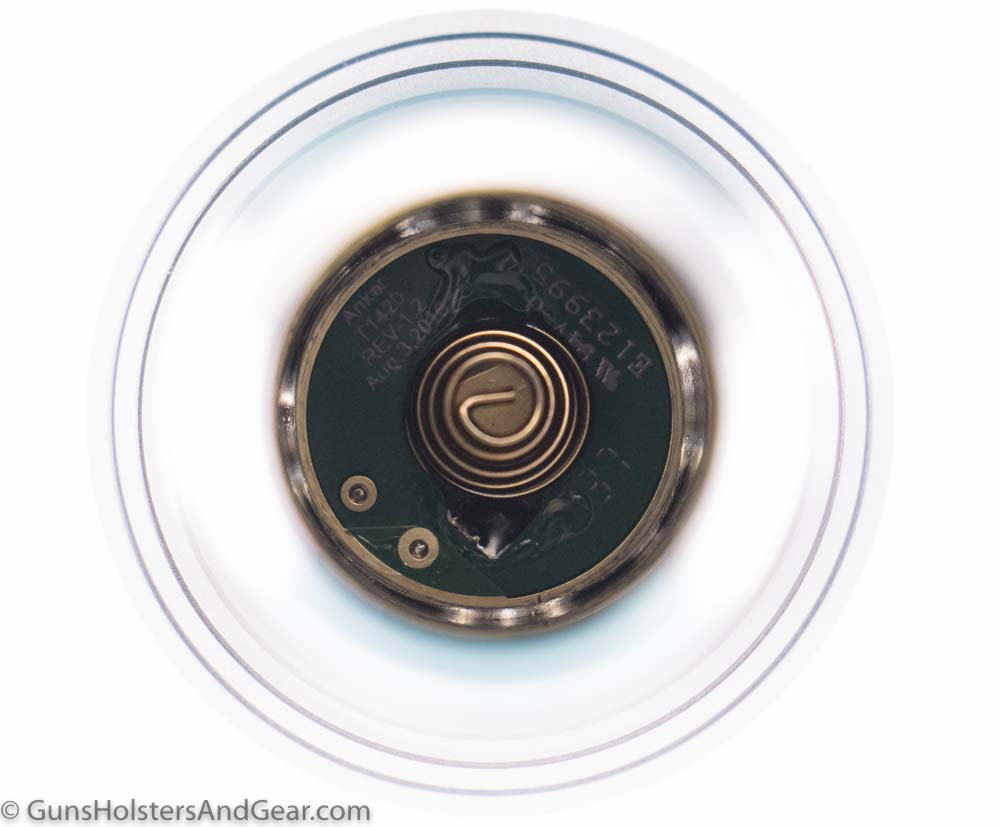
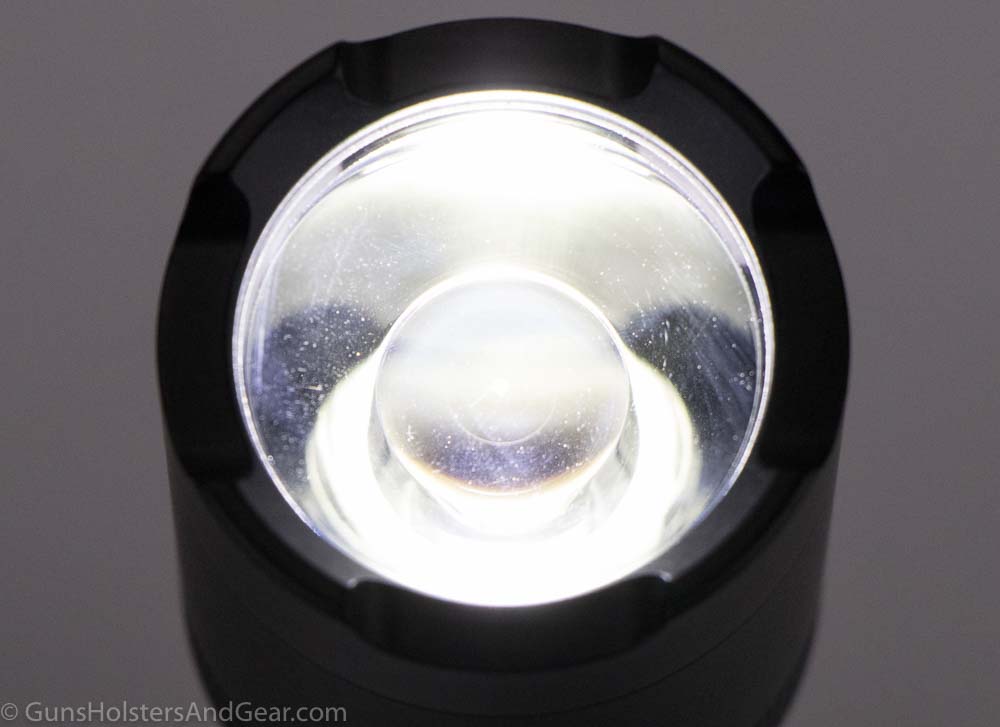
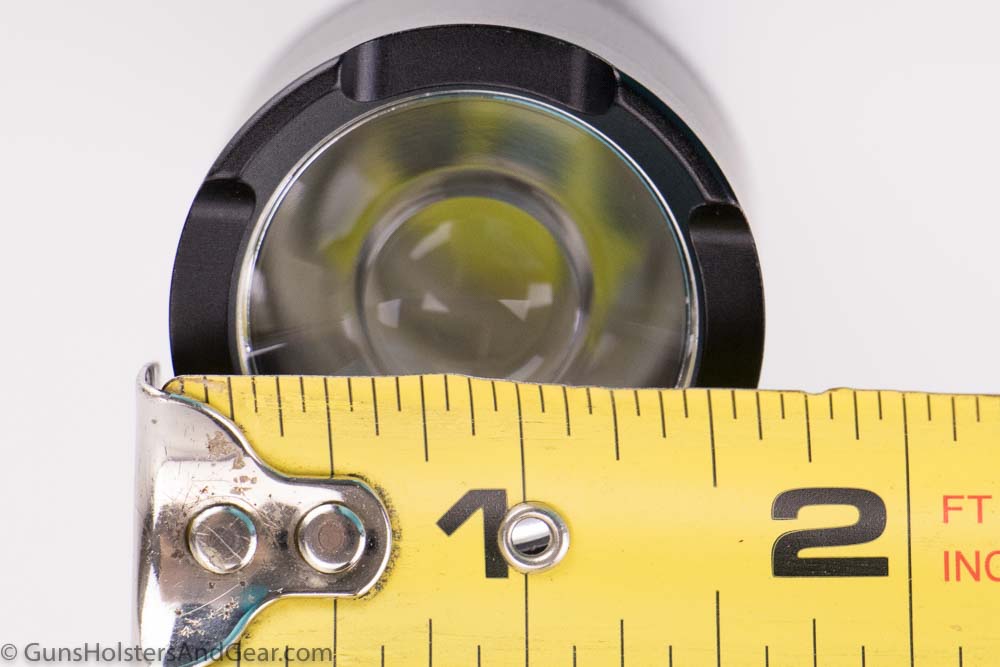
41 replies on “Anker LC90 Flashlight Review – Don’t Believe the Hype”
I was gifted a lc90 and notice in your review the model lc90 was printed on the upper part of the handle. Mine has no external lc90 markings anywhere. Otherwise it looks identical to your review. Is mine a knock off or genuine?
Hi John,
Thank you for taking the time to read my review and post a comment.
It sounds like your flashlight to be genuine. I am unsure if the flashlight you have is an updated version of the light I tested, or maybe just a new model. Here is the product you describe on Amazon: https://amzn.to/2Oq96Hq .
Thanks again,
Richard
Thank you Richard. I feel better already lol. Thanks for taking the time to reply.
Cheers,
John
Wish I had read this review sooner. I had similar experience with the LC40.
I figured Anker was a well known quality brand so the lights should be decent. I guess for 15 bucks they’re not bad but not to the quality of Thrunite, Olight, Streamlight, etc.
You should review the WOWTac A1S. It is a much better alternative/recommendation for the price point of the LC90. I don’t think most folks looking at a 25$ light are going to want to pay 60$ or more on a light. The WOWTac A1S is an excellent budget light.
Hi John,
Thanks for the feedback. I was disappointed with Anker also since I’ve had good experiences with the company’s other products. However, it seems to be a common problem with electronics companies that jump into the “tactical” flashlight market. They might know how to build a product to specs, but don’t understand the market for which they are making the gear.
I just ordered up the WOWTac A1S from Amazon, and it should be here next week. It will be interesting to see how it performs considering the company misrepresents the flashlight specifications on its own website. It lists ANSI FL 1 specifications, but the presented information does not conform to the required method of FL 1 reporting. So, on its very face, it does not appear to list accurate information. I’ll let you know how it performs.
Regarding the $25 v $60+ flashlight – I take your meaning. However, I am reviewing the lights specifically for the purpose of tactical/self-defense use. One can get by on an inexpensive flashlight, but there will always be drawbacks. I try to give everyone my observations, test results and opinions with full transparency. That way everybody can make up their own mind about what works for them at what price point. I hope that makes sense.
Of course, I’m always on the hunt for a really great sub-$30 flashlight that performs as well as a Streamlight ProTac HL or a SureFire G2X. So far, I haven’t found one.
Thanks again for reading and commenting. I look forward to testing the WOWTac.
-Richard
I dont understand why you would give the LC90 a poor rating, but then ask the consumer to consider the Streamight flashlight which isnt comparable considering it isnt usb chargeable. What other options are there?
Hi Victor,
Thanks for taking the time to read my review and asking your question. It seems like there are two things you would like me to address: (1) Why did I not recommend the LC90 and (2) What additional options exist for USB rechargeable flashlights? I’ll take these one at a time.
Why did I not recommend the LC90?
As I wrote in the opening paragraph of this review, Anker stated this was a “super bright tactical flashlightâ€. As a tactical flashlight, I have expectations that it be durable (resistant to the environment), reliable (works every time I use it), and set up in a way that lends itself to proper use by an armed civilian, police officer or soldier. The last section relates to the beam shape & brightness, do the features get in the way of its practical use, etc.
As I indicated in the “Controls” section, the way the switch is programmed is completely incompatible with tactical use. Rotating through different modes every time I use the momentary function is unacceptable for a tactical flashlight.
The requirement to disassemble the flashlight to charge it is also a detriment to tactical use. While not a deal killer, it does make it impossible to keep plugged in and expect it to be used immediately.
Of course, the company advertising that it adheres to the PLATO FL 1 standard when it does not is also another major problem. I don’t care to speculate if this was the result of an overzealous marketer or false advertising, but it is very misleading to the public.
Lastly, take a look at the “Output Over Time” section. In my testing, it took less than 2 minutes for the flashlight to drop to 50% of its initial output. Let me repeat that – after just 2 minutes, the flashlight it putting out less than half of where it started. That is unacceptable for any flashlight – especially a tactical light – in my view.
What additional options exist for USB rechargeable flashlights?
I’m assuming that you are only interested in USB rechargeable flashlights since you did not find value in the other lights I suggested in the article. I’m also assuming you are looking for only flashlights that are good quality and suitable for self-defense or law enforcement/military use. If so, there is only one flashlight I can recommend. I’ve tested other USB charging flashlights, but none qualify for a recommendation as a good tactical light.
I’ve tested the Streamlight ProTac HL USB flashlight, but I’ve not yet written the review. It is a bright light with a rugged body, usable switch and a much better (than the Anker) location of the charging port. One downside is that it is not waterproof, though you do not have to disassemble the light to plug it in. It’s output over time is much better than the Anker (about 60-65% of initial output over about 80 minutes). It also is regulated so you don’t get huge dips and spikes in the output.
If a rechargeable tactical light makes sense for your needs (they are a compromise in many situations,) I’d suggest going with an 18650 compatible flashlight and using a USB charger to keep a spare battery in an external cradle. That way you are not worried about water intrusion through the charging port, but can still keep a battery fresh.
Thanks again for reading, and I hope this helps.
-Richard
Another consumer that found your review about 36 hours too late. Now I have this light and have to live with it for a while…
With the 2 minute 50% test results, and the fact that I live in Louisville, Kentucky, I have dubbed this the “Derby” light, since the Kentucky Derby is generally a 2 minute race.
I will be reading your reviews BEFORE making my next purchase…
Hi Rob,
Thanks for reading and posting your comments. I wish my review would have been more helpful. The good news is that the light isn’t a complete dud, and it can serve very well as just a general purpose light. If you ordered yours through Amazon, you might still be able to return it for something else if you prefer. Sadly, I’ve not yet found a USB rechargeable light in the sub $50 range that meets my expectations for a tactical flashlight.
Best,
Richard
Thanks for your detailed review. Although I think a lot of your criticisms are completely fair, there’s possibly one mistake you’re making in the Output Over Time test. Many of these LED flashlights have a “boost” mode, which only lasts for a few minutes, presumably to prevent overheating the CREE chip. I know that this is the case with many Olight flashlights. Unfortunately, the Anker LC90 doesn’t actually explain this anywhere, but it does only make the claim of a 6-hour batter life on “medium beam mode”. Looking at your test, after a couple of minutes in the high 900lumen mode, it automatically drops to what might be a 400lumen mode, and stay pretty consistently there for a few hours. Something to consider
Hi Colin,
Thanks for taking the time to read the review and offering your thoughts.
You make a good point, and I did address it in the article. From the review:
I don’t think anyone would say that a 50+% drop in output is inconspicuous.
So, taking the company at its word I stand by my belief that this is an unacceptable output drop. Combined with the company’s questionable use of specifications that very closely mimic the ANSI/PLATO FL 1 specification when it does not (by its own admission) adhere to the standard…well, it begins to paint a picture.
I’ve had a positive opinion of Anker products in the past, and I still use a few of its products. However, based on my experience, I do not recommend its flashlights for any kind of tactical, self-defense or law enforcement use.
Thanks again for reading the site. I hope you check back now and again for the additional reviews I have coming out.
Best,
Richard
I had to stop reading when you started talking about the dust and water protection rating. You talk about how such a low rating would likely be because of an external charge port and in the next sentence you are saying it’s under the tail cap which I might add is sealed nicely by o-rings. I’m assuming your one of those flashlight elitists. It’s a damn good light for the money. I absolutely love mine. I found this review while trying to find a good holster for it. If you’re dumb enough to pay more than $100 for a 18650 flashlight that’s perfectly fine. It’s a free country and I’m all about capitalism however your review could turn people that can’t afford that $100 flashlight away to buying something far more inferior. I have seen a guy make a review video freezing this flashlight in water. Lighting it on fire. Dropping it from a significant height. And it worked flawlessly after all that abuse. There is a lot worse that costs a lot more.
Hi Michael,
Thanks for taking the time to leave a comment. I wish you had taken the time to actually read the article. You make false statements about what I’ve said and ascribed motives to me that do not exist. All, it would appear, to support your belief that this Anker flashlight is something that it is not.
Feel free to take the time and re-read the one thing that you claim to have read because you are falsely claiming I’ve said something that I plainly did not. Then, continue reading the article. Once done, feel free to address any of these details I point out in this review:
– the company’s admission of non-compliance to ANSI/PLATO FL 1 specifications EVEN THOUGH it prints the opposite on its packaging (some people consider this fraud though I make no such allegation. This may have simply been a miscommunication with the factory in China responsible for the light’s construction and packaging.)
– the switch interface problems
– the fact that my testing showed the light took less than 2 minutes to drop to less than 50% of its initial output
– the fact that my testing showed the light did not achieve its stated runtime even when I measured output levels to a measly 10% of initial
-Richard
Does Bolder by Anker LS90 flashlight (which I bought for £30 on eBay) is the same as Anker LS90??…..and secondly, I used it non-stop on a higher mode around 10 minutes and I didn’t notice that the brightness dropped? Explain to me please (sorry for my English).
Hi Eugene,
I would assume that the Bolder by Anker is the same as Anker, but I am unfamiliar with that naming convention. It is possible that the company is using a procedure called white labeling where someone else can stick their name on the product and sell it as their own. Regarding the light drop, there are too many variables involved for me to explain your observation. For example, were you using the highest output, did you have a fully charged battery when you first turned it on and ran it, or had it already been used for a few minutes and had drained down, etc.
Best,
Richard
Thanks for a fair and pretty thorough review. I’m another who saw it a couple of days too late. At least I got mine “free†with my Amazon Prime points, LOL. I have a couple of excellent but more expensive Streamlights but wanted to pick up a couple of cheaper lights for leaving in the car, etc.
So, it appears the Anker has a memory so that it comes on at the last function used? I didn’t see that mentioned in your review (or the lack of such a feature if it doesn’t have it). I think a memory feature is a nice thing to have so you don’t always start out in “turbo†mode—and it’s one that most of the cheaper lights lack. For what I bought it for this light is fine, I’ll just consider the “high†output mode a short-term “turbo†setting.
I purchased the Anker Bolder LC90. It’s a shame that nobody makes a “Practical” rechargeable flashlight. A simple 1 click on and 1 click off…. every time. To get a “Practical” LED flashlight…. a person needs to purchase one without the convenience of a built in charging port. You then need to equip yourself with a steady supply of disposable alkaline batteries, remember to keep buying them from the store or purchase rechargeable batteries and chargers for the house and car….. just more stuff to keep track of and lose.
It’s sucks to go into other modes by accident when you are trying to work. Really, I’d better 99 percent of people never venture so far off into the wilderness to ever need an SOS function. And I’d have to say if I’m at sea, signal flares shoot way up into the sky and will be seen for much greater distances than any light…. simply because the curvature of the Earth.
Lots of information on the internet about people soldering a jumper wire to eliminate the unwanted functions to make their flashlight “Practical”…. a simple 1 click on and 1 click off…. foolproof everything time.
There are many lights that can be programmed to have whatever modes you want, or that have mode memory so after the first time you set it to the mode you want, it will be one click on and off for that mode.
I don’t consider the charging port all that much convenience. If you want to avoid the hassles and expense of continually buying alkaline batteries then you’ll have already invested in rechargeable batteries and have a charger, and then, it is not really that much of a difference to just carry a spare 18650 cell with you instead of a USB charger and/or cable, and then the light is ready to continually use rather than having to wait for it to recharge.
You wrote more to keep track of, but I think that applies more to other widgets, not so much portable devices, batteries and chargers. It just isn’t practical to have everything USB charging at once, once you factor that you may already have a charger occupied by a phone. Rather than an individual cell charger, how much more practical is it to have USB chargers everywhere?
SOS, sure it is not needed by most people, but is it really that big a deal to press a button one more time to cycle past it? In typing your reply, you pressed buttons many times. I think you are great at pressing buttons and this shouldn’t be an issue, lol, but as I wrote initially, there are many lights that are programmable, or at least have mode memory so you never see the SOS feature unless you want to change modes.
Streamlight and Surefire are overrated and overpriced.
In what way?
Id also like to know how those 2 are overpriced? Two proven lights that cost only a bit more than this cheap, barely functional trash. Nice review!
Thanks much for your review – so much more helpful than Amazon’s, where I bought two LC90’s, both of which have had problems (I hadn’t read your review. I also write an Amazon review occasionally of products I purchase there.) My problem with both torches (including one the company kindly switched out after a phone call to service, meaning 3 altogether now) is limited to settings: I cannot get the setting to stay on the constant beam, but it goes to the strobe effect no matter how many ways I push the button (and I have read/tried a multitude of options!). The person at the service call I made to Anker said this was not a unique complaint. Your review is exceptional – much appreciation!
Your statement is puzzling, quote:
“I expect that the LC90 is not submersible mainly because of the in-light charging circuitry. Most lights that allow you to charge the battery like this are not submersible because the charging port isn’t sealed.
Anker placed the charging port under the tail cap. The tailcap must be fully removed to access the port, so I had hoped Anker managed to make this waterproof. Alas, the company did not. I’m not sure why Anker failed to make this happen.”
There is nothing about the charging puck that makes it any less waterproof. It has the same, typical construction with the tail cap using an o-ring at the top of the threads, which is used on any flashlight to waterproof it. Granted, some lights may have TWO o-rings instead of only one, but if that o-ring is in good shape (lubricating it with silicone grease is a good idea) there is no reason why water should get in there. Far more likely is that water would get in through the zooming head gasket o-ring, since it has a larger size and arguably a lot of wear if you use the zoom feature.
Hi Dave,
Thanks for taking the time to comment. Anker states the flashlight is /not/ submersible. Specifically, they state the flashlight is only splash resistant. Prior to the statements of mine you quoted, I wrote: “Anker states the light is dust and water resistant with an IP65 rating.”
As you may be familiar, an IPx5 rating is two levels of water resistance below submersible.
You can also examine the company’s documentation on this if you like. My statements were trying to understand why the company designed the flashlight as not being waterproof.
-Richard
This is by far the best flashlight i have ever owned. I’m buying one for my fiancee as well.
It looks like in your light over time graph that yes the output drops below 10% after 2 mins, but bounces back up shortly after. What is all that noise/peaks? Shouldn’t that be averaged and then the performance would be much better?
Hi Connor,
Thanks for taking the time to read and respond.
Averaging the numbers might benefit Anker, but wouldn’t alter the actual output of the flashlight. I like to err on the side of providing measured data to readers and let them decide if it is a flashlight that works for their needs. I’m always open on improving how I deliver that information.
Also, I’d like to note that the graph and text indicate output dropped below 50%, not 10%, of the initial output after just 2 minutes. Even using an average, it looks like output would still be below 50% within just a few minutes of initial operation.
-Richard
Sorry, one other thing. The spikes in output are not outside noise, rather a result of how the flashlight emits light. Higher quality drivers often provide a smoother output graph. For example, you can look at this Surefire review for a less frantic chart.
-Richard
I just received an ANKER flashlight and while trying to learn about this brand flashlight I found your review on the LC90. I was wondering if you have tested the ANKER Bolder LC90 2-Cell. The box my flashlight came in has pretty much the same information you have pictured in the review. However my light has the charging port on the butt cap next to the power/every function button. Since you reviewed the rechargeable single battery LC90 do you think your findings for the LC90 single battery would be about the same for the LC90 2-Cell? I know it is one battery vs 2 batteries however it is still “900lm” IPX5 with the 5 light modes. Just curious about your thoughts on the LC90 2-Cell flashlight.
Hi William,
I’m afraid I haven’t tested the 2-cell version of the light. It appears they claim the same specs including both output and runtime. So, I don’t know what their game is. Once you get some time with yours, would you share what you think about it? I know a lot of people appreciate hearing many views on how a flashlight performs.
-Richard
Thanks for the review. I was looking at this light. I have changed my mind. What 18650 or 21700 flashlight remains constant,the longest,with no drop down? Thanks!
The author recommends the streamlight protac hl as an alternative. That flashlight is $70 on Amazon, the LC90 is less than $30. Not a very accurate comparison at all!
Next review from this author going to be a Ford Focus vs. a Chevrolet Corvette?
I own the LC90 and it’s my favorite flashlight ever and it does stay in the door storage of my truck.
Thanks for taking the time to read my review. As you have discovered, my site is not where you want to seek confirmation bias. There are certainly plenty of sites that will tell you what you want to hear.
Specious car analogies aside, would you like to address my criticisms of the flashlight in the context in which it was reviewed? For example, the company’s misuse of the FL1 standard in an what appears to me to be an effort to mislead consumers? Or perhaps the measured output over time – again something that, in my opinion, appears to be designed by the company to artificially inflate the specifications to confuse potential buyers?
I’m genuinely happy the LC90 is your “favorite flashlight ever.” For me, it does not live up to its marketing.
-Richard
Most product reviews I see are tough to get through because authors have a tendency to inject so much personal bias into the review. Maybe some will say you’ve done that, but I don’t see it that way at all.
The word “tactical” gets slapped on so many things these days it drives me crazy. A tactical bbq grill apron? A tactical coffee mug? Are these people nuts?
I’ve owned the LC90 for about 2 years, and while I love it as a glovebox flashlight, I would never rely on it in a tactical situation for 2 of the reasons you noted. 1) Mode changing through the single function button means you cannot reliably have the desired light output when it’s most critical, and 2) it’s only especially bright just after charging.
I’m moderately annoyed when I have to cycle through 5 light modes to get the one I want in my backyard or on the roadside, but I can deal with it.
I am a big fan of Anker products, but it’s important to remember that, no matter what in-vogue marketing terms they want to slap on their products, they are a consumer electronics company. I will continue to buy their cables, chargers, and even flashlights for home use.
Thank you for the most honest, data-supported review I’ve seen in a long time. I’ll be checking out more of your site and your recommendation on the Streamlight.
Hi Rob,
Thanks for the feedback and kind words. My Anker is a solid beater light, but I think we’re on the same page regarding its tactical use. Thanks for checking out the site.
-Richard
I own it, but I bought it as a professional automation and maintenance mechanic with intermittent needs and a ready supply of random 18650 flashlights and batteries for my considerably higher quality weapon lights. I may use the charging port, but probably not often because I have a Nitecore 4-bay charger for everything from CR123r and 14500 [AA size] to 26650.
A 900 lumen output, even intermittently, is enough to do a quick look into a dark area. It stays plenty bright to do the job for a while. My big problem is that the button is the exact opposite of what works. Even the cheap lights will allow you to change the modes quickly with a slight press. This requires you to select the mode and not go past it while trying not to latch the switch. It is easier to turn the flashlight fully on and off quickly than to try and use the switch as a momentary with any dexterity.
I think that it’s a solid LED light that stays cool, and the Anker battery supplied is not exactly the best available which affects output as well. I’m not blown away by it. But, for $30, it has good output for my purposes. The charging port instead of an O ring seal is probably the only reason it doesn’t have a better water resistant value.
Definitely not my first pick for a “tactical” light, the only tactical features are the sketchy tailcap switch and crenellated bezel.
Definitely agree this is a tactical style body but only a general purpose light. If you need better specs, you need to buy a light that does one thing and does it well. For the money, it’s a lot of light in a reasonable package that can recharge via USB in a pinch that if I lose it I won’t lose sleep.
Weapon light? No. Decent cheap tool? Yeah. Durability? So far, so good. You’re not going to get a $100 flashlight for $29, but you do get a $29 flashlight.
I have had two of these for over a year and it’s impossible to find faults for a 30 buck flashlight. Both of my sons have a couple and my 3 daughters each have one.
Zero problems!
I’ve even used one many times under water for several minutes at each use with no water getting inside.
I just found this site and love what I see.
Sir, if you had to recommend a “zoomie” at around the $100 price level, what would you recommend? I have tried several $80-ish lights from the major players, but for uses of short duration, they did not seem to outperform this Shankar.
Thank you!
Thank you!
I think what’s missing in your review is that the Anker is $22, and the ones you recommend are $70+.
You’re doing the same thing all enthusiasts do, and saying that the less expensive version sucks, because it’s not as whiz-bang as your preferred one, even if it costs three times the price, just because they use the word “Tactical” in the description. Well no kidding. I would expect a light costing three times as much to do all those things a lot better.
For $22, the Anker light is **FANTASTIC**. I’d challenge you to find one for that little that is half as good.
Hi Mark,
I judged the light based on the company’s own description. If they want to go head-to-head with legitimate tactical lights, they need to build them to that level. For a knock-around light, it is good. As a tactical light, it is not. I have no investment in any flashlight company and try to provide the best information possible for readers.
In light of the credible allegations that the company is using some of its products to store and collect photo and video data without permission and then using facial recognition technology to…what? Build a database?…I cannot recommend any Anker products anymore.
For additional information:
https://www.youtube.com/watch?v=2ssMQtKAMyA
-Richard
–
We have several of these Anker flashlights. They are seriously abused as we do commercial, industrial HVACR service in old buildings in Detroit. They are the best economical flashlights we have ever used. Been dropped, been dropped in water, been driven over. We love them.